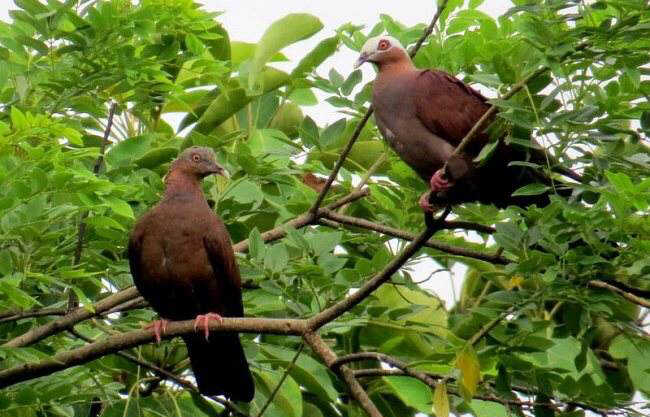Columba punicea
IUCN
LCBasic Information
Scientific classification
- name:Columba punicea
- Scientific Name:Columba punicea,Pale-capped Pigeon
- Outline:Landfowl
- Family:P.Order P.family P.genus
Vital signs
- length:35cm
- Weight:535g
- lifetime:10-20 years or so
Feature
It is a medium sized tawny and grey pigeon
Distribution and Habitat
It is distributed in Bangladesh, Cambodia, India, Lao People's Democratic Republic, Malaysia, Myanmar, Sri Lanka, Thailand, Vietnam.
Possible extinction: China.
It is found only in Tibet and Hainan Island in China.
It mainly inhabits mountainous broad-leaved forests and secondary forests and their forest margins.
Appearance
Purple pigeon forehead, head to pillow gray white, eyes and eyes are also gray white. The hindneck is light brown with purplish-red metallic luster, the upper back and scarlet, with a broad metallic green feather margin. The back and shoulders are chestnut red, the tip of the feather has a purple-red metallic luster, and the upper cover of the inner wing and the exposed part of the inner fly feather are also dark chestnut red. The waist and tail are covered with dark gray, and the tip has a reddish reddish metallic luster. The tail is dark brown. Wing margin and primary cover dark brown. The fly feathers are also dark brown, and the inner secondary fly feathers are the same back. The sides of the neck and throat are light brown and shiny, the lower body is grape chestnut and the luster is brassy, especially in the throat and breast brassy, and from the rear to the undercoat becomes a light black grape chestnut.
The iris is yellow. Red mouth, white tip; Red feet; Claws light characte
Details
The foreign name of the purple forest Pigeon is Pale-capped Pigeon, no subspecies.

Purple pigeons often live alone or in pairs. Occasionally in small groups, sexually active, fast and powerful flight. It mainly feeds on berries, figs and other plant fruits and seeds, and also eats crop seeds. It often forages in secondary forests and forest margins. Sometimes they also forage for food in agricultural fields and rice paddies outside the forest. It is found from northeast India to Southeast Asia. It is a rare resident bird in southern Tibet and Hainan Island. It should also be seen in the subtropical areas of southeastern Tibet. Move from small groups to large groups. Slow as a green dove.
The breeding period of purple forest pigeons is from May to July, and they often nest in pairs. They usually nest in mountainous evergreen broad-leaved forests, small patches of jungle or bamboo forests. Most of them are below 1500 meters above sea level and nest in the plain woods at the foot of the mountain. Each clutch lays 1 egg, the size of which is 35-42 x 27-32 mm. Male and female birds incubate their eggs in turn.
During the brooding period, pigeon milk is secreted under the action of prolactin (also known as prolactin) secreted by the posterior pituitary gland. Pigeon milk is composed of fat-filled granules, emulsified chylous fluid and lymph fluid exfoliated from the swollen flat epithelium in the lymphatic area of the bilateral lateral capsule of female and male pigeons, namely, the crop bed. After the colostrum stage, chylous fluid rich in emulsified fat particles is gradually added. In general, on the 4th to 5th day of incubation, the male and female pigeons' crop beds began to sprouted, and the blood vessels of the crop beds were congested, thickened, and lymphatic vessels hyperplasia. On the 8th to 9th day, the crop epithelium thickened and entered the pre-brooding state. On the 13th day, the thickness and width of the pigeon had doubled, transparent yellowish milk could be secreted on the 14th to 16th day, the crop could secrete the throat milk on the 18th day, but on the 7th day after the squabs emerged from the shell, the secretion of the crop milk began to decrease, and on the 10th day, the secretion stopped, and the squabs continued to retching until about 2 weeks of age, the crop bed began to shrink, and the milk secretion gradually ceased. The chymous pulp is gradually mixed into the semi-finished chymous pulp which is backflowed from the glandular stomach and ground through the muscle stomach, and then it is changed into the granule feed which is directly fed with water. If the hatched eggs fail to shell on time, the broody pigeons can continue to hatch until the 22nd to 24th day at most (these are related to the hatchability of the pigeons, the incubation season and the information feedback of embryonic development, the frequency of breaking the shell of the foetus, etc., such as in the cold winter and spring and the brooding period, the incubation period is often automatically extended, and it is often difficult to persist in the hot and hot days). At this time, the brood will automatically stop brooding with the shrinkage of the crop bed.
It was included in the List of Beneficial Terrestrial Wildlife under State Protection or of Important economic and scientific research Value issued by the State Forestry Administration of China on August 1, 2000.
Listed on the International Union for Conservation of Nature (IUCN) 2013 Red List of Threatened Species ver3.1 - Vulnerable (VU).
It is listed in the second level of the List of China's National Key Protected Wildlife.
Protect wild animals and eliminate wild meat.
Maintaining ecological balance is everyone's responsibility!








